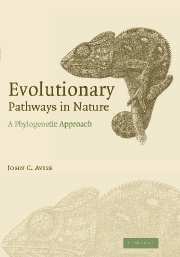Book contents
- Frontmatter
- Contents
- Preface
- Acknowledgments
- 1 Introduction
- 2 Anatomical structures and morphologies
- 3 Body colorations
- 4 Sexual features and reproductive lifestyles
- 5 More behaviors and ecologies
- 6 Cellular, physiological, and genetic traits
- 7 Geographical distributions
- Epilog
- Appendix: a primer on phylogenetic character mapping
- Glossary
- References and further reading
- Index
Appendix: a primer on phylogenetic character mapping
Published online by Cambridge University Press: 18 December 2009
- Frontmatter
- Contents
- Preface
- Acknowledgments
- 1 Introduction
- 2 Anatomical structures and morphologies
- 3 Body colorations
- 4 Sexual features and reproductive lifestyles
- 5 More behaviors and ecologies
- 6 Cellular, physiological, and genetic traits
- 7 Geographical distributions
- Epilog
- Appendix: a primer on phylogenetic character mapping
- Glossary
- References and further reading
- Index
Summary
Many recent textbooks (see References for Chapter 1) thoroughly cover the laboratory techniques of molecular genetics as well as phylogenetic methods of data analysis, at levels suitable, depending on the book, for readers ranging from novice to expert. Thus, this Appendix will confine its attention to some underlying concepts and methods specific to PCM per se. In other words, it is assumed for current purposes that appropriate molecular genetic data have been gathered and properly analyzed to estimate a robust phylogenetic tree for the taxa in question, and that the intent now is to map and interpret the distributions of particular phenotypes onto that tree. Normally, alternative states of phenotypic characters are known only for extant species (exterior nodes) of the phylogenetic tree; the goals of PCM are to infer ancestral character states at various interior nodes and to estimate character-state transitions along various tree branches. Only elementary aspects of PCM will be covered here. For far more complete and advanced treatments, including operational details, see Brooks and McLennan (1991, 2002), Eggleton and Vane-Wright (1994), Harvey and Pagel (1991), Harvey et al. (1996), Maddison and Maddison (2000), Page and Holmes (1998), and other references cited below.
History of cladistic concepts and terminology
Systematists from Aristotle to Linnaeus and beyond traditionally grouped organisms and erected biological classifications based on qualitative or quantitative appraisals of the overall resemblance (phenetic similarity) among taxa.
Information
- Type
- Chapter
- Information
- Evolutionary Pathways in NatureA Phylogenetic Approach, pp. 223 - 238Publisher: Cambridge University PressPrint publication year: 2006
